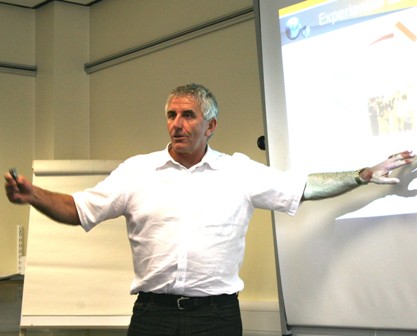
Making it work: teams come in all shapes and all sizes
Kick-starting work teams
Anyone who has had exposure to the study of team dynamics will recognise the ‘forming-norming-storming-performing’ concept which was first propounded by psychologist Bruce Tuckman in 1965. In his first article for The Leisure Review Trevor Laurence explains how to get through the first steps of team ignition quickly and set-up effective team performance for the duration of a team’s life cycle.

Making it work: teams come in all shapes and all sizes
Teams may come to a functioning dynamic naturally but in the work context it is critical that the process of team ignition is carefully structured to ensure teams quickly reach the state of effective team performance. In the recent FIFA World Cup it was very evident where teams had got this process largely right or wrong and how that affected team performance. International football teams span the work-leisure spectrum and provide readily accessible examples for comparison. As you read this article consider the team set-up and performance of Spain, Germany, or New Zealand, successful teams that performed above their expected ranking, compared to England, France or Brazil, teams which got the team set-up off-key from the start and subsequently underperformed. You will also be able to think of work teams that you have been a member of, and how the six components of team ignition may, or may not, have been put in place from the start.
To get a new work team off to a quick and effective start the first thing to do to is get the team composition correct from the beginning with the right people in the right roles. Getting the team composition and casting right lays the foundation for a high-performance team culture. High-performing teams have individuals who provide a collection of different strengths that bring both diversity and balance. When teams are forming or reforming, even just one or two changes in membership will provide the opportunity to re-evaluate what is the best fit of roles and responsibilities across the team. Adopt a strengths-based approach to team selection that considers values (behaviour and attitudes), suitability (chemistry or ‘fit for the team’) and eligibility (technical or professional ability). Where team members are able to work with a diverse range of people with major strengths in the right roles, trust and respect will be easily built and maintained. This is a key element to establishing positive chemistry or ‘alchemy’ in the team. Fabio Capello’s selection of players for the England team for the 2010 World Cup was hampered from the outset by the John Terry-Wayne Bridge issue. Leadership, team chemistry, team culture and ultimately team performance were all affected by an off-field behavioural issue that limited Capello’s selection options, significantly influencing the composition and casting of the squad taken to South Africa.
Once you have the cast assembled you need to ‘look out to look in’ to make sure you know your external team environment. In setting up your team, scan and consider the context, meaning and purpose for your team’s existence. You need to think about your external stakeholders in everything you do and build this into your planning and communication. Clarity about how your team contributes to the bigger picture helps provide a unifying focus for the team both as individuals and as a group. To understand your external environment it is imperative that you start off by identifying between three and five key external stakeholders and start collaborative planning with them around your interdependencies. Successfully working together involves being up-front with these external stakeholders about needs and requirements, both ways. Most teams will only fulfil their vision and purpose when their key stakeholders are also successful. Establishing these key relationships early in your team’s set-up is necessary to prevent the slippery slide towards unintended negative ‘group-think’ which is the consequence of the silo behaviour of many work teams. The New Zealand team had a low budget campaign compared to other nations, however excellent engagement with sponsors, the NZ Government and the general public saw an All Whites team that felt strong national support and enthusiasm throughout their African campaign.
As your team starts to come together set short-term, specific goals. These goals need to be conceived so that they define immediate team success. This process sets the basis for commitment to the team and allows immediate team traction when these short-term targets are met. It also allows time to clarify long-term vision and purpose while relationships are established with key external stakeholders. An added benefit from the goal-setting process will be the establishment of sound processes for dialogue. Setting team goals is a key part of establishing team direction. The French team at the 2010 World Cup never seemed to be truly united behind clear short term goals whereas the Germany and Spanish campaigns always appeared very well focused about both immediate goals and long term targets. In the Spanish example, even the early set-back of a loss in their first game never side-tracked the team from clarity and unified commitment to the long-term objective.
Effective team dialogue involves the development of a collective mindset that harnesses team diversity. It requires both straight talking and active listening. Dialogue flourishes when the team establishes a structure for meetings, with a clear purpose and disciplines for each meeting. Establish team ground rules and behaviour standards that match your organisation’s values. Agree how you will make team decisions and communicate both across the team and with key external stakeholders. Use the meeting structure to establish and keep track of team goals. Dialogue is a key element in a team’s effectiveness and contributes to establishing both trust and respect as well as the team’s direction. John Terry’s press release from South Africa during pool play is an example of where team dialogue has gone wrong in a team. Rather than effective straight-talking dialogue within the team, public comments were made that would have easily undermined team commitment and unity.
Winning teams know their score. They know where they stand because they have a simple and visible scorecard or dashboard that enables the team to quickly track the key dimensions of team performance, which should include aspects of both financial and non-financial performance. Establish a tracking mechanism even if accurate data is initially unavailable but can be built and developed over time. Use the dashboard to build team standards and to provide a focus on team accountability. Developing a team scorecard will provide the basis for recognition and celebration as a team, as well as for recognising valuable individuals. A team dashboard is easily established in a sports team through monitoring team results just as financial results often are the obvious result of team performance in the workplace. However, high performance teams have other equally valuable performance measures. In the workplace these may include measures such as staff engagement, customer service, project performance and staff retention.
The final step in the drive to get a team up running and delivering is accountability. Accountability is a major driver of team performance, establishing as it does a team discipline or habit of monitoring and reviewing performance against agreed goals and actions. This is key to team success and setting milestones for plans and projects provides a focus for team review and reflection. Be rigorous in using milestones to confront reality and have honest conversations about all aspects of performance, including behaviour. Accountability built around milestones ensures that the targets and measures on the team scorecard or dashboard stay in focus and turn into team achievements. As a team make sure you have honest, open conversations that confront reality about agreed plans, actions and milestones. This is a habit you should have formed in the early days of the team life cycle and will set you in good stead as a team going forwards. Sports competitions such as the World Cup have built in milestones (games), which encourage the a natural cycle of plan-do-check-act for sports teams. High performing work teams also establish this type of cycle to build a natural rhythm for their planning, monitoring and reviewing performance that facilitates both individual and mutual accountability on the team.
In a 21st-century global society which is web-connected, interdependent, and rapidly changing, work teams are formed and reformed with startling rapidity. In the UK leisure industry projects are curtailed, work sections cut or axed, whole councils are merged and downsized, and managers faced with rallying and remotivating new staff teams. Using the six steps above will ensure positive steps are taken as quickly as possible to ignite your team and get off to a fast start whatever new direction is demanded.
Trevor Laurence is managing director of Experiential Training and Coaching Ltd of Auckland , New Zealand. He is a former Olympian, performance coach to the NZ Men’s BlackSticks hockey team and a full-time facilitator-coach working with senior management teams in the corporate sector in NZ.
Trevor Laurence was one of the contributors to The Leisure Review Insight session on coaching in the September issue.
The Leisure Review, October 2010
© Copyright of all material on this site is retained by The Leisure Review or the individual contributors where stated. Contact The Leisure Review for details.
Download a pdf version of this article for printing
